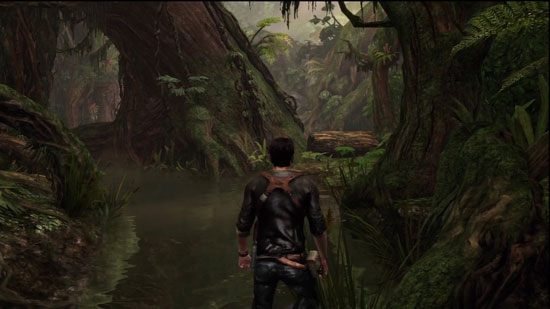Video Games Are More Than Just a Feast for the Eyes
One blind family’s visit to the landmark exhibition brought them closer to their goal—to impact the video game industry

A scene from Uncharted 2: Among Thieves, designed for PlayStation 3 in 2009. Sony Computer Entertainment America / SAAM
On March 17, Ollie Cantos took his 12-year-old triplet sons, Leo, Nic and Steven—not otherwise big fans of art—for a visit to the Smithsonian American Art Museum. But what Cantos hadn’t told the boys was that the museum was debuting its new exhibition “The Art of Video Games.”
“They absolutely live for video games,” says Cantos, an attorney that works for the federal government. The boys have a Nintendo GameCube and a Wii, also a broken PlayStation 2. They are aficionados of combat games, such as Dragon Ball Z and Marvel vs. Capcom, and play them in a room in their home equipped with a booming surround sound system.
“When we finally got there, we walked in, and they had no idea still. We went to the front desk, and I said, ‘Hi, we are here for ‘The Art of Video Games?’” says Cantos. “Suddenly, the three of them lit up. ‘Video games!’”
To a lot of folks, Cantos says, our interest in gaming seems counterintuitive. “Because none of us can see at all,” he says. “We are totally blind.” Cantos has been blind his entire life. “I have light perception, but they don’t,” he says, of his three sons.
Cantos and his sons spent more than three hours touring the exhibition. Leo, Nic and Steven played Pac-Man, Super Mario Brothers, The Secret of Monkey Island, Myst and Flower in one room, where the games are projected on backdrops 12 feet high. Another room contains an interactive timeline of the 40-year history of video games, with 20 kiosks featuring systems from the Atari 2600, released in 1977, to Wii and PlayStation 3. Each kiosk has the actual gaming device in a display case, and visitors can press buttons to hear about four games that were popular on the system. “They listened to every word on the headsets at every kiosk,” says LeeAnn Lawch, a docent at the museum.
Video games are just as addictive to the visually-impaired, explains Cantos, a former owner of an Atari 2600 and a fan of classic games including Space Invaders and Ms. Pac-Man. (He also plays Ms. Pac-Man, Angry Birds and Temple Run on his iPhone.) As for his sons, he adds, “They are making their way through the levels somehow.”
Leo, Nic and Steven prefer combat games, because they can compete head-to-head and stay within one virtual space. “I thought maybe driving games aren’t their thing, but they love Mario Kart 7,” says Cantos. “I don’t really know how they do it, but they keep doing really well.” Adventure games that require maneuvering through a three-dimensional space, jumping over and through things, are, naturally, more difficult for them. But Cantos has coached some of his sons’ friends to provide verbal cues as they navigate their way through different scenes. “Their friends feel like they get to help. They don’t want my boys to die in the game, so they are like, ‘No, no, no. Go left! Right!’ There is a lot of yelling that tends to take place. In the meantime, my boys are in suspense too. Their adrenaline is going because they are trying to do exactly what their friends tell them,” says Cantos. “When they succeed, they all feel victorious.”
As the Cantos family toured “The Art of Video Games,” Lawch read panels and described the graphics and actions of the games. A retired registered nurse, she has experience working with visually-impaired individuals. “Mostly, I tried to translate the visuals to descriptions utilizing additional senses. ‘The air appears hot. There don’t appear to be any nature sounds like birds or waterfalls—just hot, dusty and dry wind. It might smell like hot metal or burning tires,’” says Lawch. Keeping up with the action was a challenge. “He’s running through fire, jumping over a cliff. He’s going to fall. Things are exploding,” says Lawch. “I have never talked and read so fast in my life!”
Cantos and his sons visited the exhibition during the opening weekend in hopes that they would cross paths with some of the movers and shakers within the video game industry. They met Billy Mitchell, a former record holder for Kong and Pac-Man and star of the 2007 documentary “King of Kong,” as well as Chris Melissinos, the exhibition’s curator and self-admitted game addict. Now, they are eager to connect with video game designers. “The big thing that we want programmers to know is to just factor us in,” says Cantos. “We would like to not be an afterthought. We are just another part of the video game market.”
At this point, text-adventure games accommodate the visually-impaired, but many graphics-based games, popular today, could use some accessibility features. Cantos suggests that designers program the games so that menu options and any other text or narrative that appears on the screen is read aloud. Like subtitles for the deaf, maybe an option for verbal descriptions could be offered at the beginning of a game.
“My boys are willing to market test it,” says Cantos. His sons, he adds, have spread the Gospel of video gaming to others who otherwise may not have considered it much. “They are very, very passionate about this stuff,” says Cantos.
As a father, Cantos is grateful to the video game industry for providing an incentive for his sons to do well in school. “If they don’t do well with their grades, then they don’t get to play,” says Cantos. “They are just like any other kids. They like to have fun.”
/https://tf-cmsv2-smithsonianmag-media.s3.amazonaws.com/accounts/headshot/megan.png)
/https://tf-cmsv2-smithsonianmag-media.s3.amazonaws.com/accounts/headshot/megan.png)